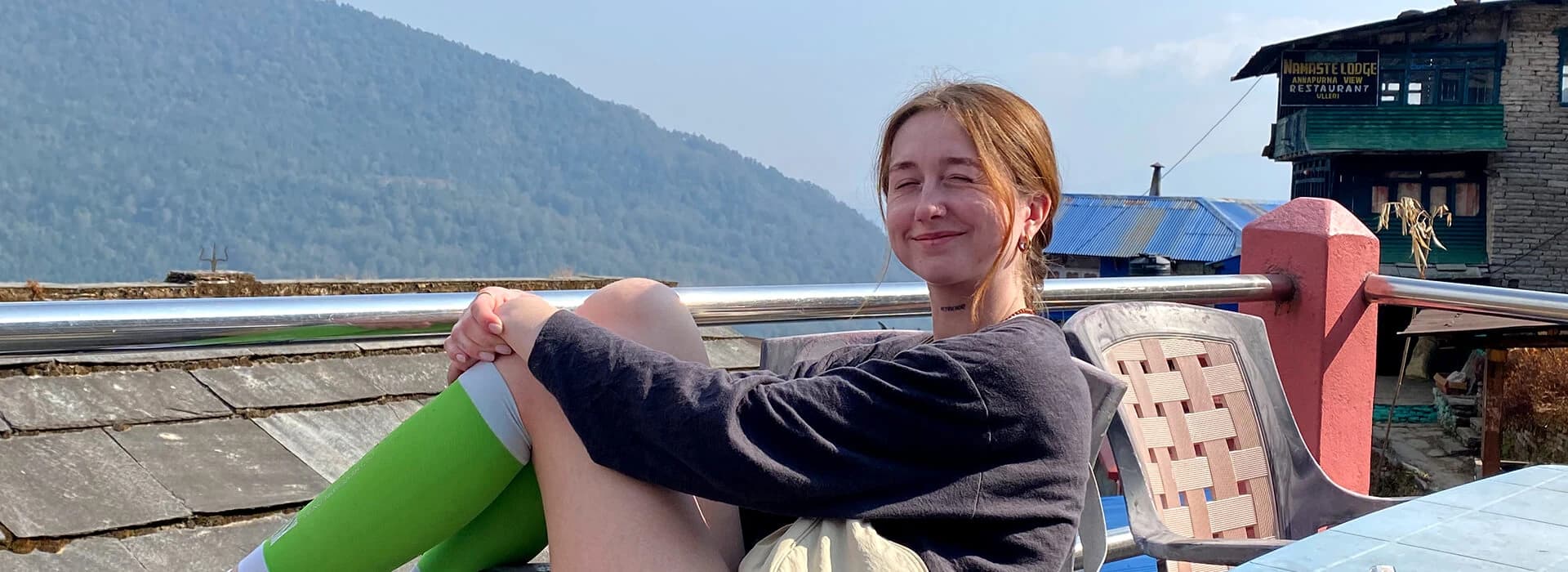Short treks in Nepal are ideal for beginners and those limited by time and budget to experience the real beauty of Mother Nature. The country is well-known for adventure activities, especially for trekking and mountaineering. Thousands of tourists visit here for these outdoor recreational activities.
Climbing a peak is extremely hard and requires advanced training. On the other hand, trekking also falls under the category of hard adventure. Yet it does not need any training, can be done by people of almost every age group, and the difficulty level varies depending on the trail.
This blog is about short treks in the country; therefore, we'll discuss trekking more deeply than any other adventure activity. Just because it's categorised as a hard adventure, you don't need to worry about thinking you cannot enjoy the beauty of Nepal's Himalayas, as I've already stated that the difficulty level depends on the trail and the duration of the journey.
This country offers numerous trekking routes that aren't technically demanding and can be finished easily within a week for first-timers and busy individuals. That's why trekking has drawn the attention of numerous people from around the world here.
Keep hanging on with me till the end of the blog. I have prepared some of the brief treks in Nepal that suit you, if you are an inexperienced hiker or even an experienced one, but are tight on time or budget.
I can assure you that you will not regret trekking to any of these destinations later. All of the trails offer you panoramic views of the peaks in the Himalayas, stunning landscapes, and the local culture and traditions of the region.
Aren't you excited now to know what those short treks could be? I hope you're already thinking of planning to go on an adventure in Nepal.
Some of the short treks in the country that I have listed below offer you magnificent views of Nepal's Himalayas from various regions. It is sure that you will observe nature's beauty even within a short period. It proves that to learn and experience nature-related things, you don't need to spend a long time away from your comfort zone.
Ghorepani Poonhill Trek
Location
-
Myagdi and Kaski Districts, Gandaki Province, Western Development Region
Difficulty Level
-
Moderate
Highest Altitude
-
Poon hill 3,210 m (10,525 ft)
Duration
-
6 days
Temperature
-
Approximately 16°C to 25°C in the daytime and 8°C to 14°C at nighttime at lower elevations (800–2,000 m), and approximately 10°C to 18°C in the daytime and 2°C to 8°C at nighttime at mid-elevations (2,000-4,500 m) during spring.
-
Approximately 15°C to 24°C in the daytime and 8°C to 14°C at nighttime at lower elevations, and 10°C to 17°C in the daytime and 2°C to 7°C at nighttime at mid-elevations during autumn.
-
Approximately 8°C to 15°C in the daytime and 0°C to 5°C at nighttime at lower elevations, and 2°C to 10°C in the daytime and -5°C to 0°C at nighttime at mid-elevations during winter.
-
Approximately 20°C to 28°C in the daytime and 15°C to 20°C at nighttime at lower elevations, and 10°C to 20°C in the daytime and 5°C to 15°C at nighttime at mid elevations during monsoon.
Mountain Range
-
Dhaulagiri and Annapurna
Permit
-
Annapurna Conservation Area Permit (ACAP)
-
Trekkers’ Information Management System (TIMS)
Major Attractions
-
Blooming Rhododendron Forests
-
Gurung Villages
-
Peaks such as Dhampus Peak (6,012/19724.41 ft), Machhapuchhre (Mt. Fishtail, 6,993 m/22,943 ft), Annapurna I (8,091 m/26545.28 ft), Dhaulagiri I (8,167 m to 26795 ft), etc.
Mardi Himal Trek
Location
-
Kaski District, Gandaki Province, Western Development Region
Difficulty Level
-
Moderate
Highest Altitude
-
Mardi Base Camp (4,500 m/14764 ft)
Duration
-
6 to 7 days
Temperature
-
Same as the Ghorepani Poon Hill Trek, as it's also located in the Annapurna Region.
Mountain Range
-
Annapurna
Permit
-
Annapurna Conservation Area Permit (ACAP)
-
Trekkers’ Information Management System (TIMS)
Major Attractions
-
Blooming Rhododendron Forests
-
Gurung Villages
-
Peaks such as Mardi Himal (5,588 m/18333.33 ft), Nilgiri (6,940 m/22769.03 ft), Machhapuchhre (Mt. Fishtail, 6,993 m/22,943 ft), Annapurna I (8,091 m/26545.28 ft), Manaslu (8,163 m/26,782 ft), Dhaulagiri I (8,167 m to 26,795 ft), etc.
Annapurna Base Camp Trek
Location
-
Kaski District, Gandaki Province, Western Development Region
Difficulty Level
-
Moderate
Highest Altitude
-
Annapurna Base Camp (4,130 m/13,550 ft)
Duration
-
6 to 7 days
Temperature
-
Same as the Ghorepani Poon Hill Trek, as it's also located in the Annapurna Region.
Mountain Range
-
Annapurna
Permit
-
Annapurna Conservation Area Permit (ACAP)
-
Trekkers’ Information Management System (TIMS)
Major Attractions
-
Gurung culture and tradition
-
Modi River and Waterfall
-
Ice Cave
-
Peaks such as Hiunchuli (6,441 m/21,132 ft), Machhapuchhre (Mt. Fishtail, 6,993 m/22,943 ft), Tilicho Peak (7,134 m/23,409 ft), Gangapurna (7,455 m / 24,459 ft), Annapurna I (8,091 m/26545.28 ft), Dhaulagiri I (8,167 m to 26,795 ft), etc.
Annapurna North Base Camp Trek
Location
-
Myagdi District, Gandaki Province, Western Development Region
Difficulty Level
-
Moderate
Highest Altitude
-
Annapurna North Base Camp (4,190 m/13,747 ft)
Duration
-
5 to 6 days
Temperature
-
Same as the Ghorepani Poon Hill Trek, as it's also located in the Annapurna Region.
Mountain Range
-
Annapurna
Permit
-
Annapurna Conservation Area Permit (ACAP)
-
Trekkers’ Information Management System (TIMS)
Major Attractions
-
Magar culture and tradition
-
Sky Cave
-
Phutpute Waterfall
-
Miristi River
-
Panchakunda Lake
-
Peaks such as Nilgiri North (7,061 m/23,166 ft), Tilicho Peak (7,134 m/23,409 ft), Annapurna I (8,091 m/26545.28 ft), etc.
Langtang Valley Trek

Location
-
Rasuwa District, Bagmati Province, Central Development Region
Difficulty Level
-
Moderate
Highest Altitude
-
Tserko Ri (5,033m/ 16,500 ft)
Duration
-
8 days
Temperature
-
Approximately 15°C to 25°C in the daytime and 7°C to 12°C at nighttime at lower elevations (800–2,000 m), 10°C to 18°C in the daytime and 2°C to 7°C at nighttime at mid elevations (2,500–3,000 m), and 5°C to 12°C in the daytime and -5°C to 0°C at nighttime at higher elevations (3,800 m+) during spring.
-
Approximately 14°C to 22°C in the daytime and 6°C to 12°C at nighttime at lower elevations, 8°C to 16°C in the daytime and 0°C to 5°C at nighttime at mid elevations, and 2°C to 10°C in the daytime and -6°C to -2°C at nighttime at higher elevations during autumn.
-
Approximately 6°C to 12°C in the daytime and 0°C to 5°C at nighttime at lower elevations, 0°C to 8°C in the daytime and -5°C to 0°C at nighttime at mid elevations, and -5°C to 2°C in the daytime and -15°C to -5°C at nighttime at higher elevation during winter.
-
Approximately 18°C to 26°C in the daytime and 12°C to 18°C at nighttime at lower elevations, 14°C to 20°C in the daytime and 8°C to 14°C at nighttime at mid elevations, and 8°C to 15°C in the daytime and 2°C to 8°C at nighttime at higher elevations during monsoon.
Mountain Range
-
Langtang
Permit
-
Langtang National Park Entry
-
Trekkers’ Information Management System (TIMS)
Major Attractions
-
Tamang and Tibetan Buddhist culture and tradition
-
Bhote Koshi River
-
Peaks such as Langtang Lirung (7,234 m/23,734 ft), Langtang Ri (7,205 m/23,638 ft), Dorje Lakpa (6,966 m/22,854 ft), Loenpo Gang (6,979 m/22,897 ft), Changbu (6,781 m/22,247 ft), and others
Gosaikunda Trek

Location
-
Rasuwa District, Bagmati Province, Central Development Region
Difficulty Level
-
Moderate
Highest Altitude
-
Gosaikunda (4,380 m/14,370.08 ft)
Duration
-
5 days
Temperature
-
Same as the Langtang Valley Trek, as it's also located in the Langtang Region.
Mountain Range
-
Langtang
Permit
-
Langtang National Park Entry
-
Trekkers’ Information Management System (TIMS)
Major Attractions
-
Gosaikunda, Saraswati Kunda, Bhairab Kunda, Surya Kunda, Naga Kunda, and Peaks such as Manaslu (8,163 m/26,782 ft), Ganesh Himal (7,422 m/24,350.39 ft), Langtang Lirung (7,234 m/23,734 ft), Langtang Ri (7,205 m/23,638 ft), Gaurishankar Himal (7,134 m/23,406 ft), Dorje Lakpa (6,966 m/22854.33 ft), etc
Pikey Peak Trek
Location
-
Solukhumbu District, Koshi Province, Eastern Development Region
Difficulty Level
-
Moderate
Highest Altitude
-
Pikey Peak (4,065 m/13,337 ft)
Duration
-
5 to 6 days
Temperature
-
Approximately 10°C to 18°C in the daytime and 2°C to 8°C at nighttime at lower elevations (2,000-3,000 m), and 6°C to 14°C in the daytime and -2°C to 4°C at nighttime at mid elevations (3,000-4,000 m) during spring.
-
Approximately 8°C to 17°C in the daytime and 0°C to 6°C at nighttime at lower elevations, and 5°C to 12°C in the daytime and -4°C to 2°C at nighttime at mid elevations during autumn.
-
Approximately 5°C to 10°C in the daytime and -5°C to 0°C at nighttime at lower elevations, and 0°C to 6°C in the daytime and -10°C to -2°C at nighttime at mid elevations during winter.
-
Approximately 15°C to 22°C in the daytime and 10°C to 16°C at nighttime at lower elevations, and 10°C to 17°C in the daytime and 5°C to 10°C at nighttime at mid elevations during monsoon.
Mountain Range
-
Mahalangur
Permit
-
Sagarmatha National Park Fees
-
Trekkers’ Information Management System (TIMS)
Major Attractions
-
Sherpa culture and tradition
-
Peaks such as Mt. Everest (8,848.86 m/29,032 ft), Lhotse (8,516 m/27,940 ft), Makalu (8,485 m/27,838 ft), Kanchenjunga (8,586 m/28169.29 ft), and other neighbouring peaks.
Why Are Short Treks In Nepal Popular?
Short treks in Nepal are popular among adventure seekers from around the world because of the following reasons:
Best For Busy Individuals
Hikes ranging from 3 to 8 days are basically considered short treks. They allow you to experience the beautiful environment of the Himalaya within the mentioned time frame. You don't need to worry about extending your leave to witness anything more.
Yes, there are always more and more in the Himalaya Region of Nepal. Nevertheless, you can still have enough and worth spending views of the landscapes and other things in such a tight schedule.
Pass To Sensational Landscapes
In spite of the fact that the travelling duration just spans from 3 to 8 days, the above-mentioned treks still succeed in offering all the mind-blowing scenery that you have always dreamed of. From nature's beauty to local ethnic culture, everything you will enjoy during the adventure, and take back home as a memory for a lifetime.
Budget-Friendly Journey
The more days you travel, the more expensive your journey will be. Trekking does not always mean spending more to witness some amazing nature-related things you have been dreaming of for a long time.
If you're currently tight on your budget but still want to experience the real beauty of nature, you can have it within the adventure of a week. Some short treks in the country that I've stated earlier provide you with magnificent views of Nepal's Himalaya, lush green forest, traditional villages, and wildlife encounters.
Culture Engagement
Besides nature, Nepal is also a culturally rich country. As a result, all these treks offer you the beautiful culture and tradition of the local ethnic group along the trail.
For instance, the Annapurna Region is occupied mostly by the Gurung people. Thus, during trekking, you will get involved in their community and learn their culture, language, festivals, cuisine, etc..
Physical And Mental Peace
Within a short period of a maximum of 8 days, you can have your great physical condition and mental peace. During the trek, you walk and cover a long distance, which burns the fat and calories in your body, strengthens your legs, and improves your immune system.
Apart from this, a nature walk is also a kind of mental therapy that we all need to have at least once a year. That sound of rivers, waterfalls, birds, and the smell of soil helps reduce your stress and overcome the hectic life of the regular job you do in the cities.
Suitable For All Kinds of People
Short Treks are worth going for both experienced and beginners, and every age group. You can enjoy and find peace of life in such a short time, even if you are adventuring for the first time. All these treks have plenty of tea houses to give you proper accommodation along the way, making your journey even easier.
What Is The Best Season For Short Treks In Nepal?
Two seasons are believed to be the best for short treks in Nepal: spring (March to May) and autumn (September to November). Below are several things that define these seasons as ideal for travel purposes:
-
There will be plenty of daylight to enjoy hiking in the warm temperatures, warm days and chilly nights.
-
Days in spring and autumn are generally clear and with great visibility of the peaks in the Himalayas.
-
The chances of weather issues are minimal, such as heavy rain, snow, landslides, floods, and avalanches, which ensures trekking is safe.
-
In spring, there are a lot of blooming wildflowers on the trails, and in autumn, there is lush green everywhere.
-
You will also have an opportunity to experience Nepali culture. During spring, you will participate in festivals such as Holi (Festival of Colours), Nepali New Year, and Buddha Purnima (Buddha's birthday). During autumn, you will celebrate Dashain and Tihar (Nepal's biggest festivals).
-
All trails are maintained well for the most part, and all lodges and teahouses carrying authentic and flavorful best food are operating, with clean accommodations being available at every stop.
-
These two seasons are also great for photographers. You'll have an opportunity for spectacular photos of the mountains and landscapes, as many as you want, while on trek.
Altitude Sickness In Nepal
Altitude sickness in Nepal is common during trekking at high altitude locations. Once you make it up to 3,000 m (9,843 ft), you'll be close to it. There are three types of altitude sicknesses: Acute Mountain Sickness (AMS), High-Altitude Pulmonary Edema (HAPE), and High-Altitude Cerebral Edema (HACE).
AMS is just a first phase, and the rest of the two are the outcomes of your carelessness while already dealing with one of the symptoms of it. HAPE and HACE can even cost you your life if you aren't cured in time.
So, it'll be so much better for you in future if you're aware of their symptoms, which are as listed in the table below:
|
Altitude Sickness |
Symptoms |
|
AMS |
|
|
HAPE |
|
|
HACE |
|
Best Prevention Tips
-
Don't push yourself beyond the limit while ascending. Instead, walk slowly and patiently by taking frequent breaks of at least 5-7 minutes along the trail.
-
Drink as much water as you can, at least 3-4 litres a day. Your body must remain hydrated all the time while trekking at high elevations. Besides, eat foods with a high amount of water, like apples and cucumbers.
-
Eat food full of carbohydrates, like potatoes, pasta, and rice, because they take time to digest, and as long as such foods remain in your body, you'll stay energised.
-
Spend an extra day once you reach 3,000 m to acclimate your body.
-
Take the best medicine to avoid altitude sickness, acetazolamide (Diamox), under the guidance of your trusted doctor.
-
Eat garlic every day before starting your day hike, as it's considered a natural acetazolamide.



